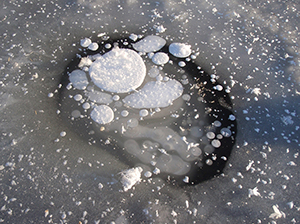The first time geneticist George Church visited Siberia was the first summer the permafrost melted.
- By STEPHANIE DUTCHEN
Permafrost by its nature is supposed to stay frozen year-round, but in a marker of encroaching climate change, in 2018 the top layer of soil thawed and didn't refreeze. Microbes began to eat the carbon that had been locked away in the ice and released it into the air as methane gas. Church watched a teammate light a match and ignite a pocket of the gas that hovered over the softening bog they stood in.

"That was an ominous sign," Church recalled. Today, he says, thawing permafrost is burping up methane "at an alarming rate," given that the gas "is 30 times more potent than carbon dioxide in contributing to global warming."
The sight reinforced Church's determination to combat climate change by ensuring that the world's permafrost stays frozen, keeping its estimated 1.4 trillion tons of stored carbon-two and a half times more than the Amazon rainforest harbors-tucked safely away.
His plan for doing so: Genetically modifying a group of elephants to thrive in the cold and moving them north so their daily activities contribute to preserving and restoring Arctic environments.
Harvard Medicine News spoke with Church about this unusual approach to climate mitigation and the latest developments in his lab's efforts. Church is the Robert Winthrop Professor of Genetics in the Blavatnik Institute at Harvard Medical School and a founding core member of the Wyss Institute for Biologically Inspired Engineering at Harvard University.
HM News: There have been a lot of headlines about resurrecting mammoths to repopulate and reshape the Arctic tundra. What exactly are you doing?
Church: People tend to use the shorthand that we're de-extincting mammoths: bringing them back to life after the last of them died about 4,000 years ago. We're not. At least, not in the foreseeable future. We're trying to de-extinct genes. The field has actually already done this with two genes that confer cold-resistant properties to organisms. The idea is to safely introduce these and other genes into present-day elephants so the elephants can comfortably live in and restore Arctic environments.
HM News: Why manipulate elephant genomes?
Church: The main reasons have to do with biodiversity and climate mitigation.
A question we get asked frequently is, Why de-extinct something that already had its chance; why don't you focus on endangered species and saving them from going extinct? Well, that's exactly what we're doing. We're dealing not with mammoths but with modern endangered species.
All elephant species are endangered. We're trying to give them new land in the Arctic that's far away from humans, who are the major culprits causing extinction. We're trying to cure Asian elephant-specific herpesvirus, which can be deadly, especially in young elephants. We're trying to develop tools that might be useful for other endangered species that other teams might be interested in working on.
The two-for-one is that not only would the elephants get a new homeland, but their homeland is in desperate need of environmental restoration, and they can help. Moving genetically adapted elephants to the Arctic offers an opportunity to sequester, or remove from the atmosphere, significant amounts of carbon and to prevent more carbon from escaping.
Understanding how this might work requires connecting a few dots. Elephants knock over trees, reducing bark that absorbs sunlight and heats the ground. Clearing a portion of the tree cover allows the animals to walk through new areas and pack down the snow there, facilitating permafrost freeze. Otherwise, the snow forms a fluffy, insulating layer that keeps the topsoil warm.
Basically, the idea is that we need to convert a portion of trees in the Arctic back to grass, and elephants are the only living large herbivore that will do that. They do so quickly and easily, and they like doing it. So a genetically adapted elephant-mammoth hybrid might prove to be a good proxy species for the ecological role the woolly mammoth used to play.
HM News: Why dig up genes from the past?
Church: We're trying to gather genetic diversity. We know diversity is useful for survival in a changing or new environment, and we're getting better at identifying and gathering genes that are important for a given trait-in this case, cold tolerance and virus resistance.
We're no longer limited to searching for beneficial genes in one elephant herd or even the global elephant population; now we can go all around the world, even to distant species, and back in time up to 1 million years to discover and obtain those genes. The DNA that mammoths left behind in their bones can offer us the genetic code for traits like warm, woolly hair and thick, subcutaneous fat.
HM News: How are you engaging with the ethical questions raised by this kind of work?
Church: Most of the projects I've worked on in my career-like the publicizing and privacy of personal genomes, development of devices that print synthetic DNA, gene drives that eliminate malaria parasites from mosquitoes-require broad public engagement. The problem isn't always getting scientists engaged; it's getting the public engaged. People are focused on how to put food on the table and get their kids educated. The latest cutting-edge scientific thing is not always perceived as important.
As a start, my research group has worked with HMS geneticist Ting Wu's Personal Genetics Education Project to brief Congressional staffers, who then bring information back to their constituents. We're working with writers who reach millions of people through their narratives-and the Arctic elephant story resonates particularly well. We're reaching out to representatives of key populations, including people from Indigenous groups, Arctic farming communities, other industries, and governments. We'll engage with anyone who wants to participate, whether they take a positive or negative view of the work.






